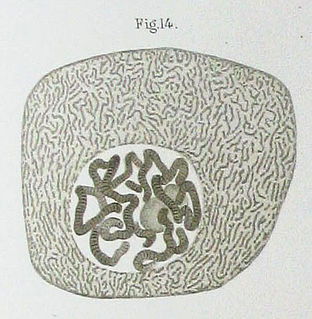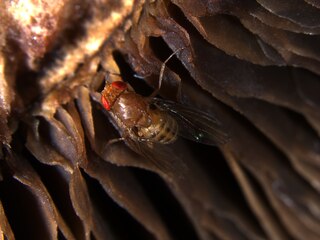
Drosophila is a genus of flies, belonging to the family Drosophilidae, whose members are often called "small fruit flies" or pomace flies, vinegar flies, or wine flies, a reference to the characteristic of many species to linger around overripe or rotting fruit. They should not be confused with the Tephritidae, a related family, which are also called fruit flies ; tephritids feed primarily on unripe or ripe fruit, with many species being regarded as destructive agricultural pests, especially the Mediterranean fruit fly.

Drosophila melanogaster is a species of fly in the family Drosophilidae. The species is known generally as the common fruit fly or vinegar fly. Starting with Charles W. Woodworth's proposal of the use of this species as a model organism, D. melanogaster continues to be widely used for biological research in genetics, physiology, microbial pathogenesis, and life history evolution. As of 2017, six Nobel prizes had been awarded for research using Drosophila.

Allopatric speciation, also referred to as geographic speciation, vicariant speciation, or its earlier name, the dumbbell model, is a mode of speciation that occurs when biological populations become geographically isolated from each other to an extent that prevents or interferes with gene flow.

Polytene chromosomes are large chromosomes which have thousands of DNA strands. They provide a high level of function in certain tissues such as salivary glands of insects

An inversion is a chromosome rearrangement in which a segment of a chromosome is reversed end to end. An inversion occurs when a single chromosome undergoes breakage and rearrangement within itself. Inversions are of two types: paracentric and pericentric.

The Drosophilidae are a diverse, cosmopolitan family of flies, which includes fruit flies. Another unrelated family of flies, Tephritidae, also includes species known as "small fruit flies". The best known species of the Drosophilidae is Drosophila melanogaster, within the genus Drosophila, and this species is used extensively for studies concerning genetics, development, physiology, ecology and behaviour. This fruit fly is mostly composed of post-mitotic cells, has a very short lifespan, and shows gradual aging. As in other species, temperature influences the life history of the animal. Several genes have been identified that can be manipulated to extend the lifespan of these insects. Additionally, Drosophila subobscura, also within the genus Drosophila, has been reputed as a model organism for evolutionary-biological studies.

The Drosophilinae are the largest subfamily in the Drosophilidae. The other subfamily is the Steganinae.
The paraphyletic subgenus Sophophora of the genus Drosophila was first described by Alfred Sturtevant in 1939. It contains the best-known drosophilid species, Drosophila melanogaster. Sophophora translates as carrier (phora) of wisdom (sophos). The subgenus is paraphyletic because the genus Lordiphosa and the species Hirtodrosophila duncani are also placed within this subgenus.
The mechanisms of reproductive isolation are a collection of evolutionary mechanisms, behaviors and physiological processes critical for speciation. They prevent members of different species from producing offspring, or ensure that any offspring are sterile. These barriers maintain the integrity of a species by reducing gene flow between related species.
FlyBase is an online bioinformatics database and the primary repository of genetic and molecular data for the insect family Drosophilidae. For the most extensively studied species and model organism, Drosophila melanogaster, a wide range of data are presented in different formats.

Heteroneura is a natural group in the insect order Lepidoptera that comprises over 99% of all butterflies and moths. This is the sister group of the infraorder Exoporia, and is characterised by wing venation which is not similar or homoneurous in both pairs of wings. Though basal groups within the Heteroneura cannot be identified with much confidence, one major subgroup is the leaf-mining Nepticuloidea. Species in this subgroup include some of the smallest lepidoterans identified.

The mir-2 microRNA family includes the microRNA genes mir-2 and mir-13. Mir-2 is widespread in invertebrates, and it is the largest family of microRNAs in the model species Drosophila melanogaster. MicroRNAs from this family are produced from the 3' arm of the precursor hairpin. Leaman et al. showed that the miR-2 family regulates cell survival by translational repression of proapoptotic factors. Based on computational prediction of targets, a role in neural development and maintenance has been suggested.

Drosophila is a paraphyletic subgenus of the genus Drosophila, a classification of fruit flies. This subgenus was first described by Alfred Sturtevant in 1939. Members of the subgenus Drosophila can be distinguished from other Drosophilid species by breaks in the pigmentation along the dorsal section of their abdomen.

Drosophila appendiculata is a large yellowish fruitfly found in Southern Chile and neighboring Argentina. The species is placed in its own unique subgenus, Chusqueophila, based on the presence of three partial cross-veins in the wing.

Drosophila subobscura is a species of fruit fly in the family Drosophilidae. Originally found around the Mediterranean, it has spread to most of Europe and the Near East. It has been introduced into the west coasts of Canada, the United States, and Chile. Its closest relative is Drosophila madeirensis, found in the Madeira Islands, followed by D. guanche, found in the Canary Islands. These three species form the D. subobscura species subgroup. When they mate, males and females perform an elaborate courtship dance, in which the female can either turn away to end the mating ritual, or stick out her proboscis in response to the male's, allowing copulation to proceed. D. subobscura has been regarded as a model organism for its use in evolutionary-biological studies.
Drosophila mauritiana is a species of fly, belonging to the family Drosophilidae. It belongs to the Drosophila melanogaster species subgroup. It is found in Mauritius.

Mushroom-feeding Drosophila are a subset of Drosophila flies that have highly specific mushroom-breeding ecologies. Often these flies can tolerate toxic compounds from Amanita mushrooms.
Drosophila metlerri, commonly known as the Sonoran Desert fly, is a fly in the genus Drosophila. The species is found in North America and is most concentrated along the southern coast of California and in Mexico. D. mettleri are dependent on plant hosts, namely, the saguaro and cardon cacti. Thus, they are most prevalent in arid, desert conditions. It is able to detoxify chemicals found in the rotting liquid of cacti hosts, which allows it to use otherwise lethal soil as a nesting site.

Drosophila silvestris is a large species of fly in the family Drosophilidae that are primarily black with yellow spots. As a rare species of fruit fly endemic to Hawaii, the fly often experiences reproductive isolation. Despite barriers in nature, D. silvestris is able to breed with D. heteroneura to create hybrid flies in the laboratory.













